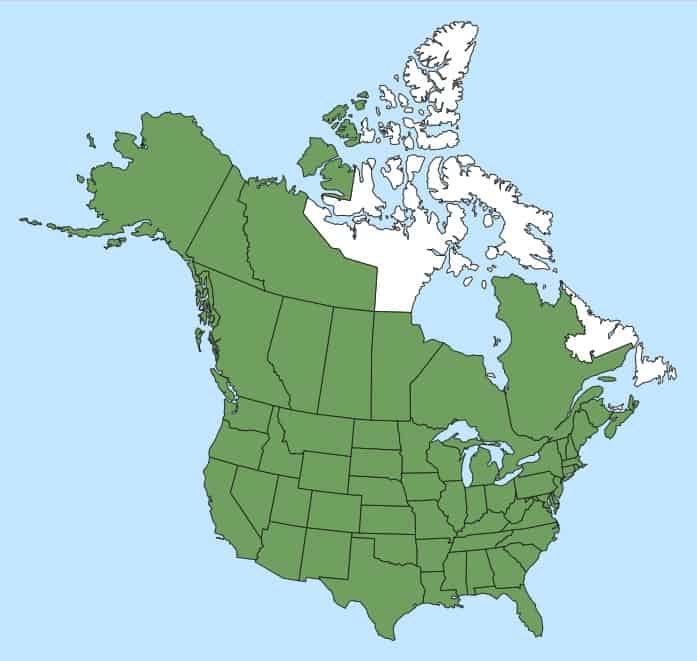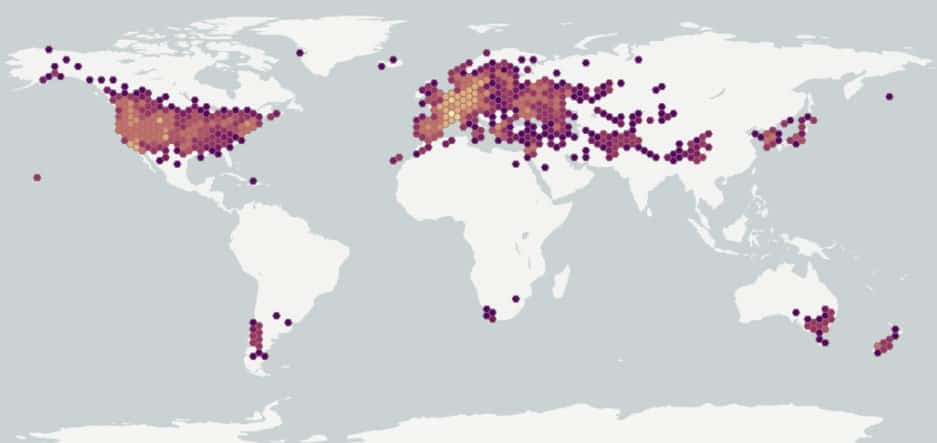Bromus tectorum
Overview
Aperçu
Regulation :
Remarques Réglementation:
- CFIA Weed Seeds Order - Class 3: Secondary Noxious Weed Seeds
Regulation Notes:
Distribution :
Répartition :
Native to northern Africa and temperate Eurasia with a broad distribution extending from Portugal in the west to China in the east (USDA-ARS 2021). Introduced in Greenland, Iceland, Japan, Australia, New Zealand, South Africa, and North and South America (Upadhyaya et al. 1986; USDA-ARS 2021). Widely distributed throughout North America and sometimes used as forage for livestock in spring and fall (Whitson et al. 1992; Barkworth et al. 2007; Beck 2009). Occurs in most Canadian provinces and territories with the exception of Newfoundland, Prince Edward Island and Northwest Territories (Brouillet et al. 2010+).
Habitat and Crop Association :
Habitat et Cultures Associées :
Dry areas, sand dunes, cultivated fields, pastures, rangelands, along railway lines and roadsides, and in disturbed areas (Darbyshire 2003; Barkworth et al. 2007). A weed of winter cereals, Medicago sativa (alfalfa) and grass fields, orchards and vineyards, pastures and grasslands (Morrow and Stahlman 1984; Upadhyaya et al. 1986; CABI 2021).
In western North America it dominates large areas of Artemisia tridentata (sagebrush) and mixed grass prairie ecosystems (Ogle et al. 2003; Barkworth et al. 2007; Beck 2009). Commonly occurs on dry, mostly alkaline, sandy to loamy soils (Peeper 1984).
Economic Use, cultivation area, and Weed Association :
Utilisation économique, zone de culture et association de mauvaises herbes :
Duration of Life Cycle :
Durée du cycle vital:
Annual or winter annual
Dispersal Unit Type :
Type d’unité de dispersion :
Floret
General Information
RENSEIGNEMENTS GÉNÉRAUX
Bromus tectorum was accidently introduced to western North America with cereal crops in the late 1800s, and was deliberately seeded in some pastures for forage and spread rapidly from there (Mack 1981). It is a prolific seed producer and common seed contaminant (Whitson et al. 1992). B. tectorum has a dual role as a serious weed and important forage, and is still used for early spring forage in the intermountain and Pacific Northwest regions (Upadhyaya et al. 1986; Barkworth et al. 2007). It is now considered the most widespread and damaging invasive annual grass in western and Midwestern grasslands (Finnerty and Klingman 1962; Rinella et al. 2013).
.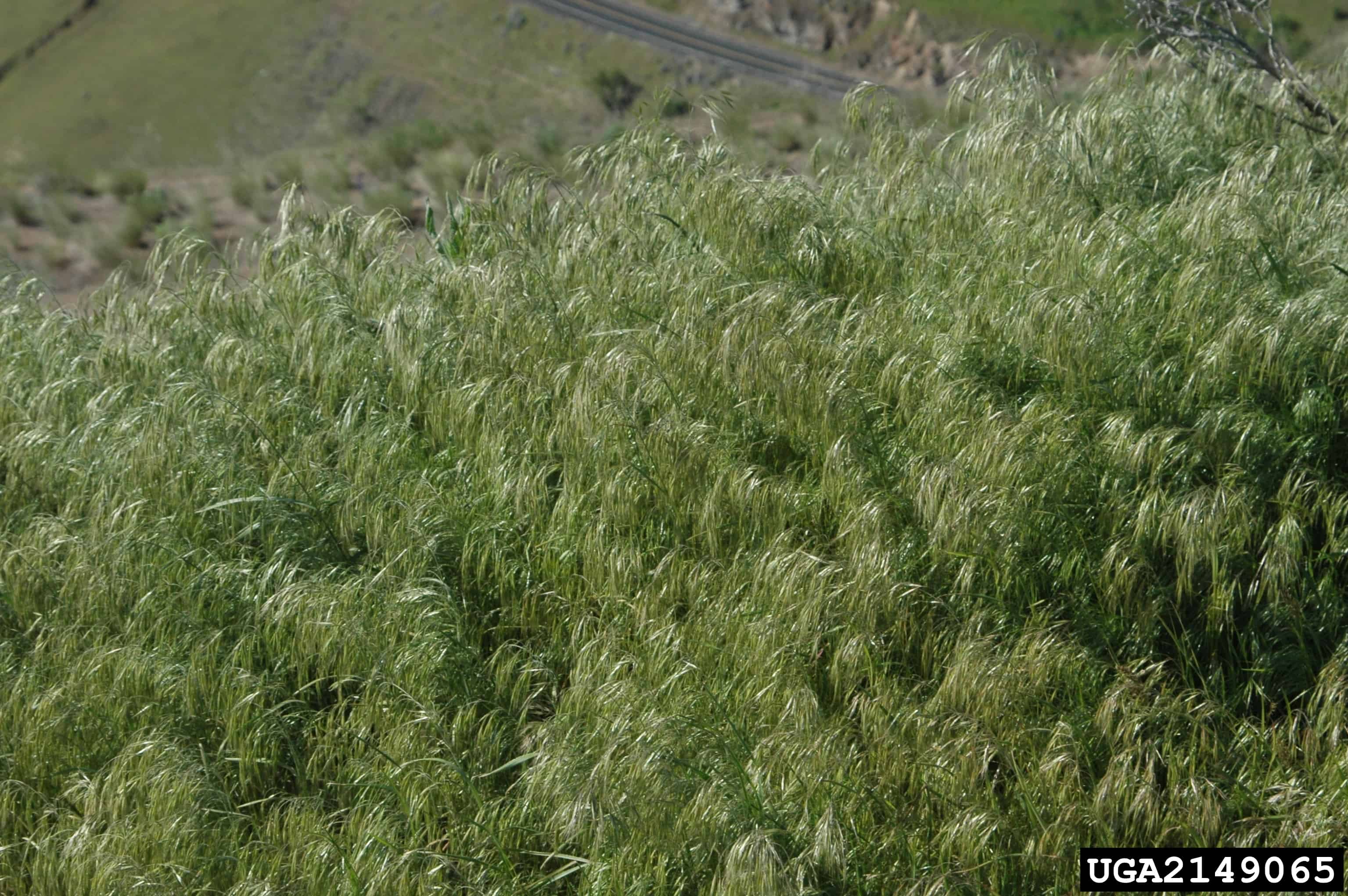
Bromus tectorum infestation (Chris Evans, University of Illinois, Bugwood.org)
Identification
Identification
-
Spikelet
Size
- Spikelet length: 10.0 – 20.0 mm (Barkworth et al. 2007)
Shape
- Spikelet is oval or wedge-shaped, compressed in edge view
Surface Texture
- Spikelet is generally densely hairy, some are smooth
Colour
- Spikelets are straw yellow, reddish-purple or purple coloured
Other Features
- Spikelets with 4 – 8 florets
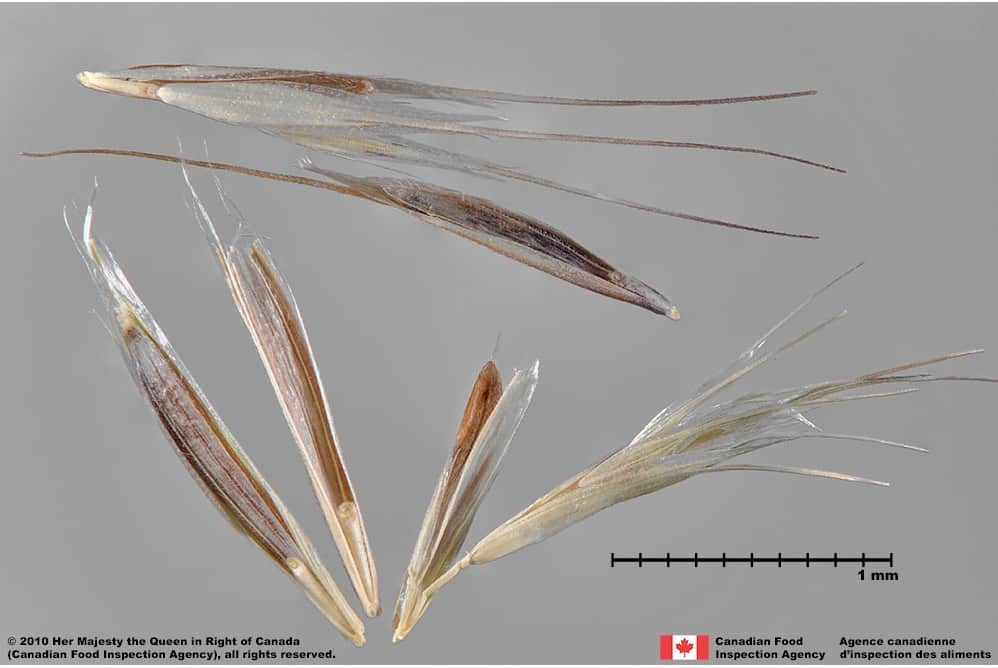
Downy brome (Bromus tectorum) florets and spikelets

-
Floret
Size
- Floret length*: 8.9 – 13.3 mm; width: 1.2 – 1.6 mm
*Note: minimum and maximum of 10 florets in a normal range of this species using image measurement (ISMA 2020)
Shape
- Long oval-shaped floret curved towards lemma side
Surface Texture
- Floret generally hairy with short or long hairs, some florets can be smooth
Colour
- Florets are straw-yellow, reddish-purple or purple coloured
Other Features
Lemma awn
- Lemma awn length: 10.0 – 18.0 mm (Barkworth et al. 2007)
Callus and Rachilla
- Rachilla generally extends 1/3 the length of the floret
- Rachilla straight, compressed in edge view and densely short hairy
Other features
- Lemma ends in 2 pointed lobes 0.8 – 2.0 mm long (Barkworth et al. 2007) that are thin and translucent
- Lemma has thin, translucent edges
- Palea thin and translucent, can generally see the caryopsis behind it
- Palea teeth are long, thin, and widely spaced
- Palea is generally as long or slightly shorter than the lemma
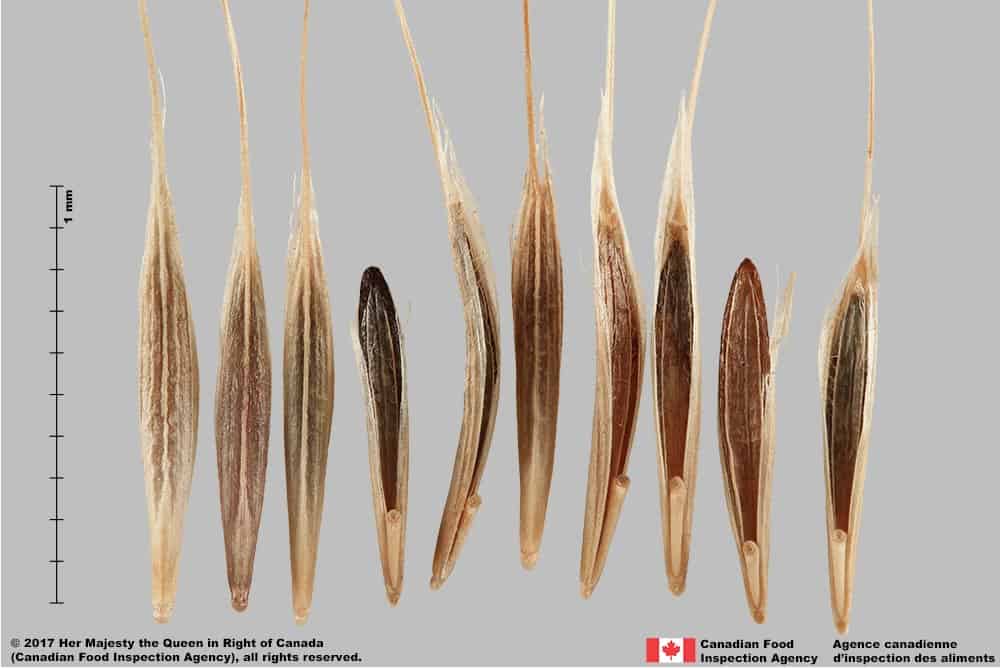
Downy brome (Bromus tectorum) florets

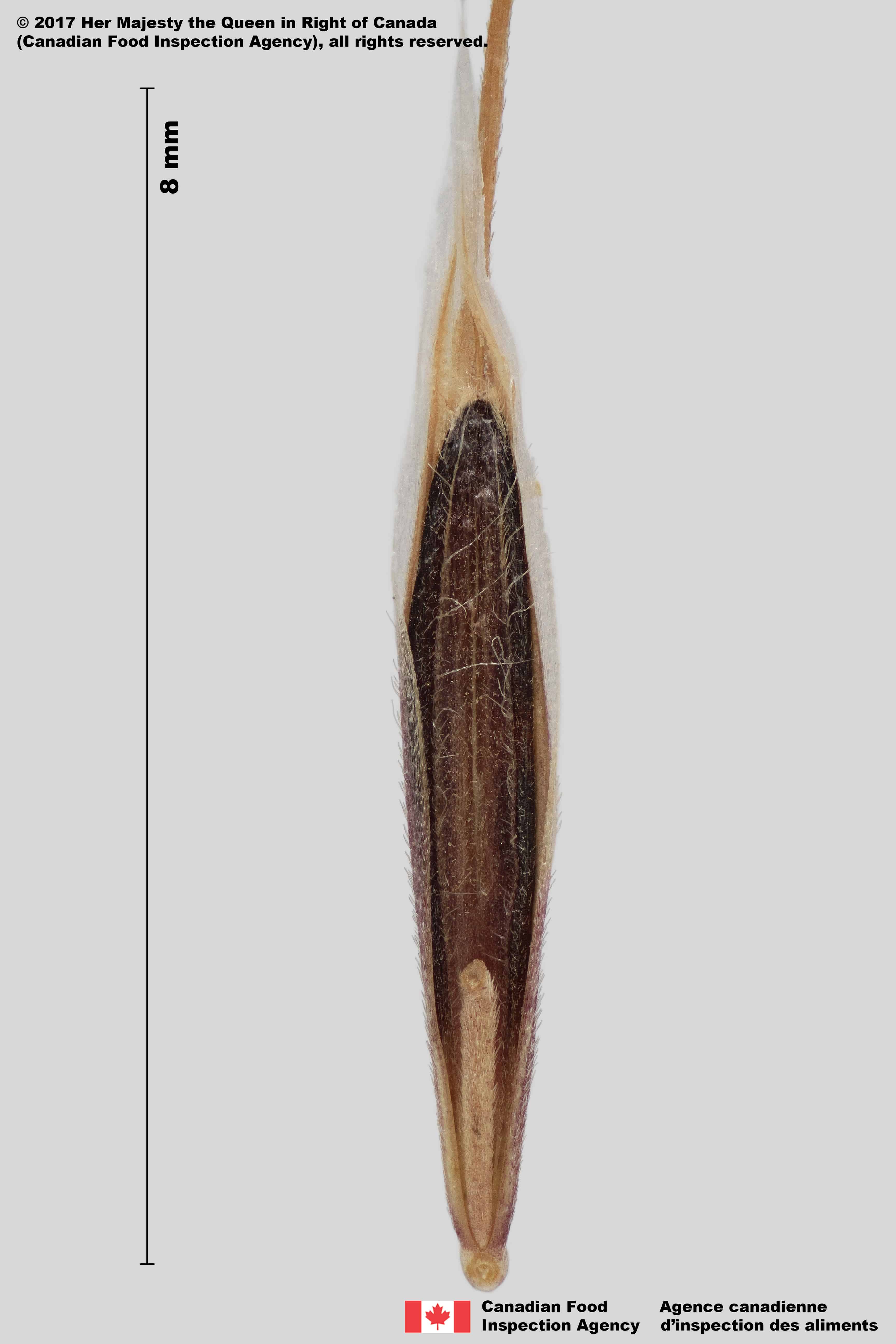
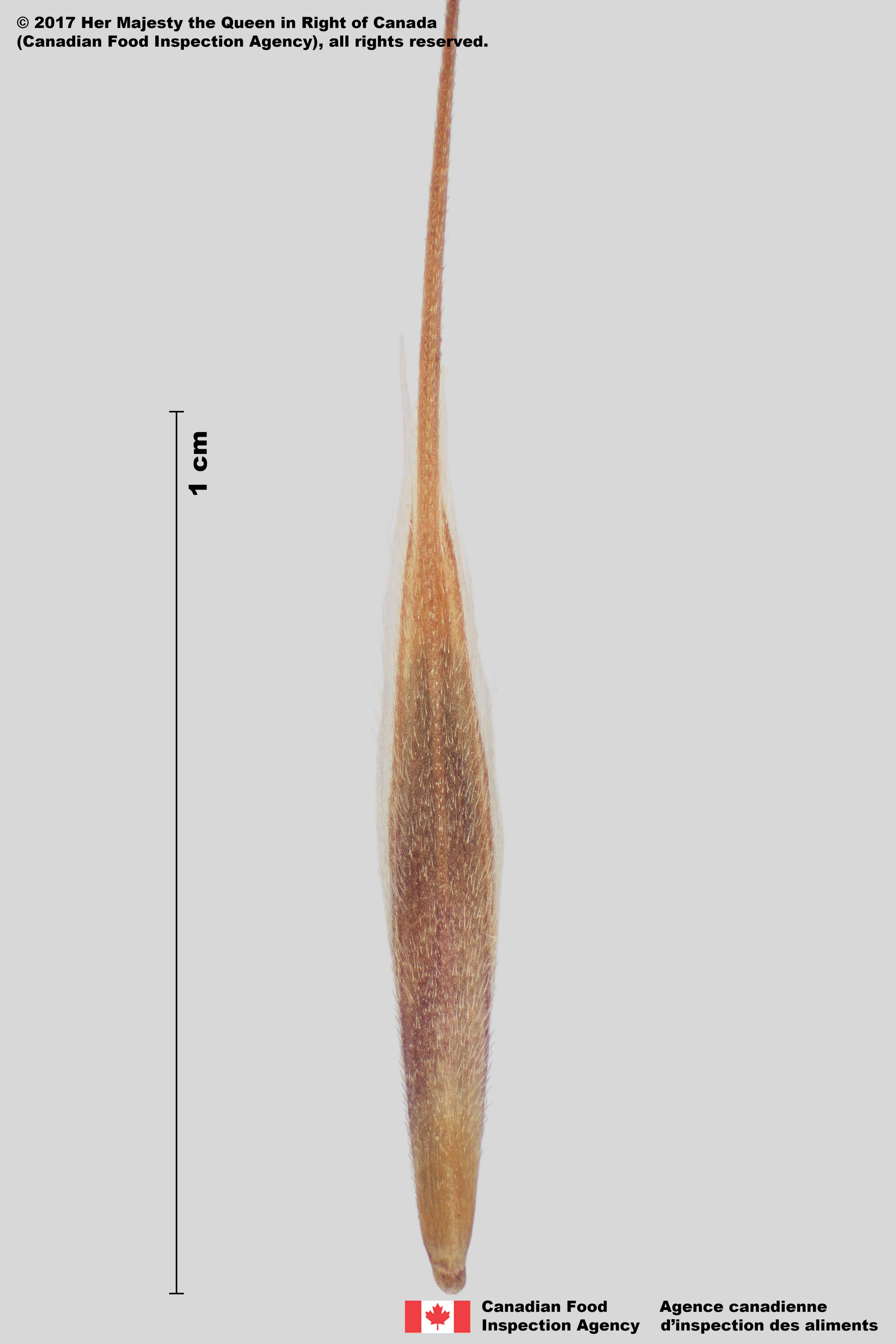
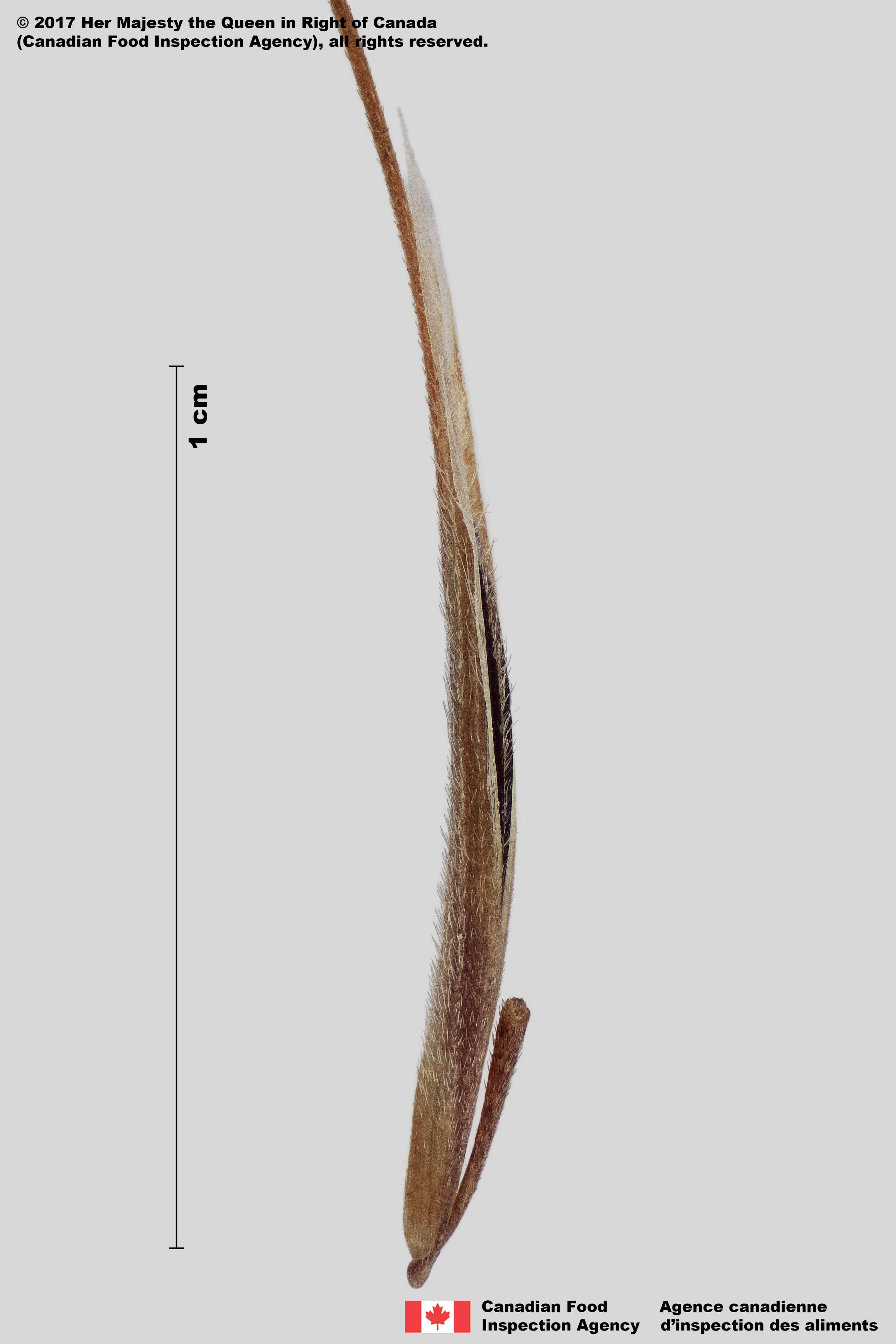
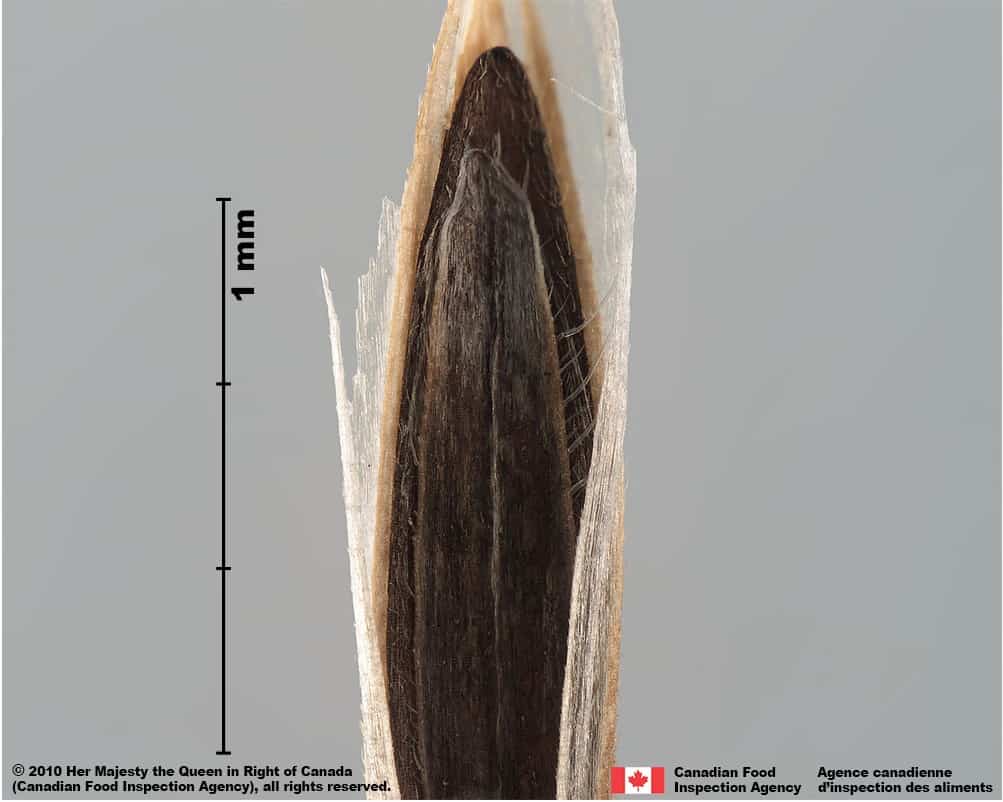
-
Caryopsis
Size
- Caryopsis length*: 8.0 – 10.3 mm; width: 1.3 – 1.8 mm
*Note: minimum and maximum of 5 caryopses in a normal range of this species using specimen measurement (ISMA 2020)
Shape
- Caryopsis is long oval shaped, generally flattened in edge view, some may have curled edges
Surface Texture
- Caryopsis is a smooth texture
Colour
- Caryopsis is generally dark purple, some are reddish-brown
Other Features
- Caryopsis is generally as long as the palea
- A linear, black coloured hilum extends the length of the caryopsis
-
Embryo
Size
- Embryo is a rudimentary size compared to the caryopsis
Shape
- Embryo is oval or wedge-shaped and located at an end of one flat side of the caryopsis
Endosperm
- Endosperm is hard and opaque white coloured
Identification Tips
CONSEILS POUR L’IDENTIFICATION
There are a number of Bromus species with florets that are long and flat with long palea teeth such as B. tectorum, B. sterilis, B.rubens, and B. diandrus. The florets of B. tectorum are the shortest of the similar species, generally have a flat, purple coloured caryopsis, and long palea teeth. B. diandrus, B. rubens, and B. sterilis florets generally have longer florets with flat or folded reddish or brown caryopses and shorter palea teeth.

Downy brome (Bromus tectorum) florets





Additional Botany Information
AUTRES RENSEIGNEMENTS BOTANIQUES
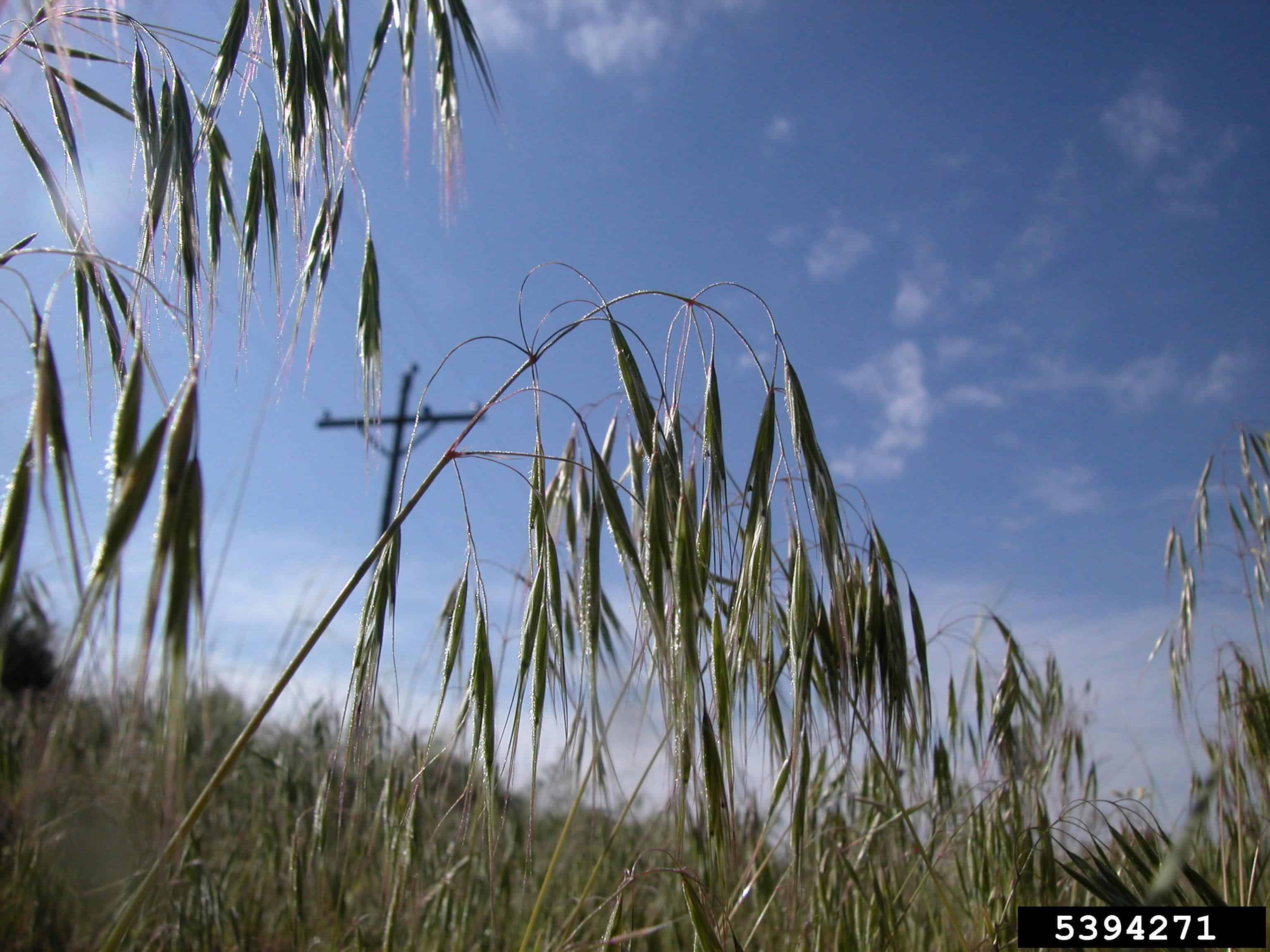
Bromus tectorum plant (Bruce Bosley, Colorado State University, Bugwood.org)

Similar Species
ESPÈCES SEMBLABLES
Similar species are based on a study of seed morphology of various species, and those with similar dispersal units are identified. The study is limited by physical specimen and literature availability at the time of examination, and possibly impacted by the subjectivity of the authors based on their knowledge and experience. Providing similar species information for seed identification is to make users aware of similarities that could possibly result in misidentification.
Bromus sterilis L. (barren brome)
B. sterilis florets are longer (length*: 10.1 – 20.3 mm; width: 1.3 – 1.9 mm) with a longer awn (15.0 – 30.0 mm) (Barkworth et al. 2007) compared to B. tectorum. B. sterilis florets have smaller palea teeth, a brown caryopsis that can be flat or folded compared to the long palea teeth and the flat, purplish caryopsis of B. tectorum.
*Note: minimum and maximum of 10 florets in a normal range of this species using image measurement (ISMA 2020)
Click to select species
Cliquez pour sélectionner les espèces
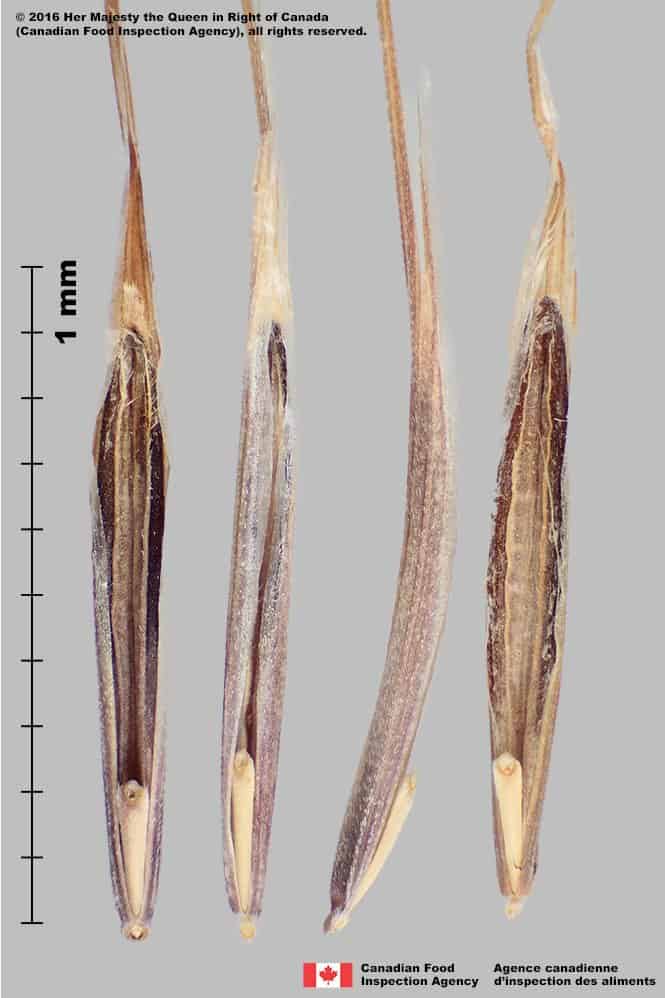
Bromus sterilis
Comparison Window
Fenêtre de comparaison
MAIN SPECIES
ESPÈCES PRINCIPALES
Bromus tectorum

Bromus tectorum
Poaceae
Downy brome (Bromus tectorum) florets
MAIN SPECIES
ESPÈCES PRINCIPALES
Bromus tectorum

Bromus tectorum
Poaceae
Downy brome (Bromus tectorum) florets and spikelets
MAIN SPECIES
ESPÈCES PRINCIPALES
Bromus tectorum

Bromus tectorum
Poaceae
Bromus tectorum
MAIN SPECIES
ESPÈCES PRINCIPALES
Bromus tectorum

Bromus tectorum
Poaceae
Bromus tectorum
MAIN SPECIES
ESPÈCES PRINCIPALES
Bromus tectorum

Bromus tectorum
Poaceae
Bromus tectorum
MAIN SPECIES
ESPÈCES PRINCIPALES
Bromus tectorum

Bromus tectorum
Poaceae
Downy brome (Bromus tectorum) floret; palea teeth
SIMILAR SPECIES
ESPÈCES SEMBLABLES
Bromus sterilis

Bromus sterilis
Poaceae
Barren Brome (Bromus sterilis) florets
SIMILAR SPECIES
ESPÈCES SEMBLABLES
Bromus sterilis
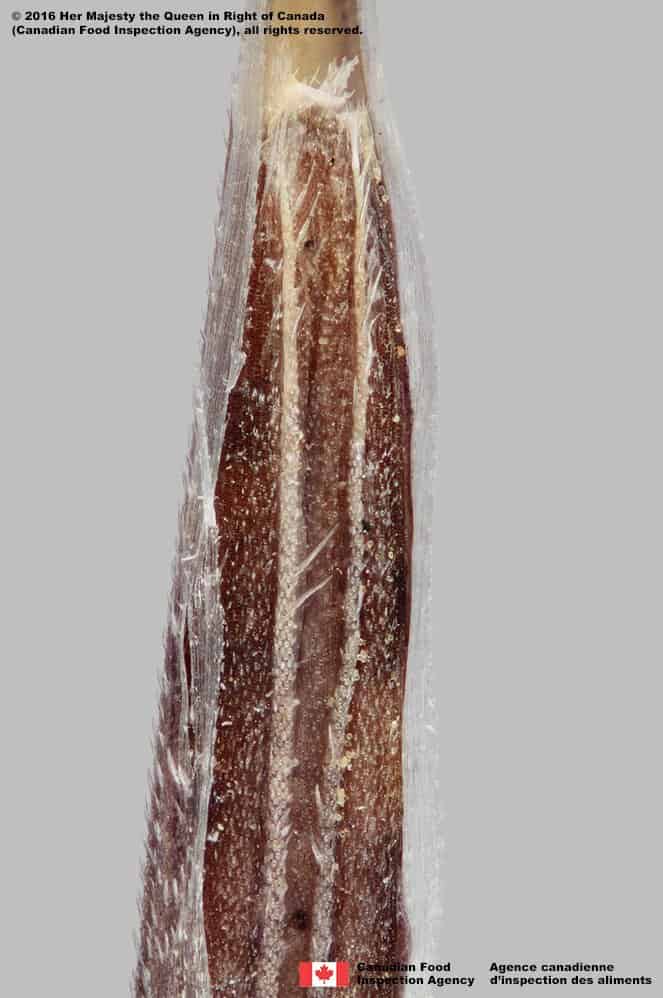
Bromus sterilis
Poaceae
Barren Brome (Bromus sterilis), palea teeth
SIMILAR SPECIES
ESPÈCES SEMBLABLES
Bromus sterilis
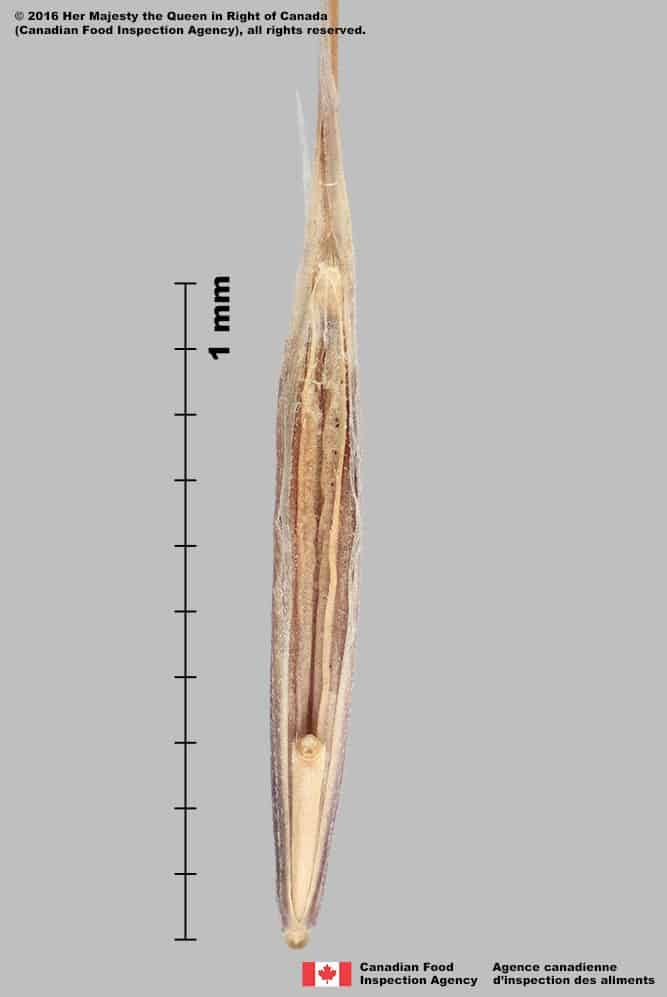
Bromus sterilis
Poaceae
Barren Brome (Bromus sterilis) floret
Need ID Help?
Besoin d’aide pour l’identification?
Reference(s)
Référence(s)
Barkworth, M. E., Capels, K. M., Long, S., Anderton, L. K. and Piep, M. B., (eds.) 2007. Volume 24. Magnoliophyta: Commelinidae (in part): Poaceae, part 1. Oxford University Press, New York, New York.
Beck, K. G. 2009. Downy brome (Bromus tectorum) and Japanese brome (Bromus japonicus) Biology, Ecology, and Management. Literature Review. Colorado State University, http://mining.state.co.us/SiteCollectionDocuments/DownybromeandJapanesebromeliteraturereviewColoradoDRMSDec09.pdf Accessed May 30, 2016.
Brouillet, L., Coursol, F., Meades, S. J., Favreau, M., Anions, M., Bélisle, P. and Desmet, P. 2010+. VASCAN, the database of vascular plants of Canada. http://data.canadensys.net/vascan/ Accessed March 3,2021.
Centre for Agriculture and Bioscience International (CABI). 2021. Invasive Species Compendium, CAB International, Wallingford, UK. https://www.cabidigitallibrary.org/journal/cabicompendium Accessed March 3, 2021.
Darbyshire, S. J. 2003. Inventory of Canadian Agricultural Weeds. Agriculture and Agri-Food Canada, Research Branch. Ottawa, ON.
Finnerty, D. W. and Klingman, D. L. 1962. Life cycles and control studies of some weed bromegrasses. Weeds 10 (1): 40-47.
Flora of North America (FNA) Editorial Committee, eds. 1993+. Flora of North America North of Mexico [Online]. 22+ vols. New York and Oxford. Accessed December 29, 2022.
Global Biodiversity Information Facility (GBIF) Secretariat. 2022. https://doi.org/10.15468/39omei Accessed via https://www.gbif.org/species/2703746 Accessed December 29, 2022.
Government of Canada (GC). 2016. Canadian Weed Seeds Order. https://laws-lois.justice.gc.ca/eng/regulations/SOR-2016-93/page-2.html (English) https://laws-lois.justice.gc.ca/fra/reglements/DORS-2016-93/page-2.html (French)
International Seed Morphology Association (ISMA). 2020. Method for Seed Size Measurement. Version 1.0. ISMA Publication Guide. https://www.idseed.org/authors/details/method_for_seed_size_measurement.html
Mack, R. N. 1981. Invasion of Bromus tectorum L. into western North America: An ecological chronicle. Agro-Ecosystems 7: 145-165.
Morrow, L. A. and Stahlman, P. W. 1984. The history and distribution of downy brome (Bromus tectorum) in North America. Weed Science 32 (Supplement 1): 2-6.
Ogle, S. M., Reiners, W. A. and Gerow, K. G. 2003. Impacts of exotic annual brome grasses (Bromus spp.) on ecosystem properties of northern mixed grass prairie. American Midland Naturalist 149 (1): 46-58.
Peeper, T. F. 1984. Chemical and biological control of downy brome (Bromus tectorum) in wheat and alfalfa in North America. Weed Science 31 (Supplement 1): 18-25.
Rinella, M. J., Masters, R. A. and Bellows, S. E. 2013. Effects of growth regulator herbicide on downy brome (Bromus tectorum) seed production. Invasive Plant Science and Management 6 (1): 60-64.
Upadhyaya, M. K., Turkington, R. and McIlvride, D. 1986. The Biology of Canadian Weeds. 75. Bromus tectorum L. Canadian Journal of Plant Science 66: 689-709.
U.S. Department of Agriculture-Agricultural Research Services (USDA-ARS). 2021. Germplasm Resources Information Network (GRIN), https://npgsweb.ars-grin.gov/gringlobal/taxon/taxonomysimple.aspx Accessed March 3, 2021.
Whitson, T. D., Burrill, L. C., Dewey, S. A., Cudney, D. W., Nelson, B. E., Lee, R. D. and Parker, R. 1992. Weeds of the West. Western Society of Weed Science, Jackson, Wyoming.



